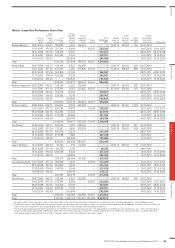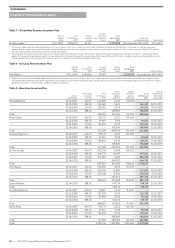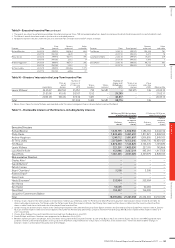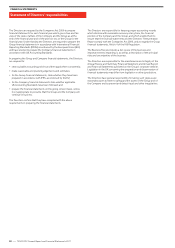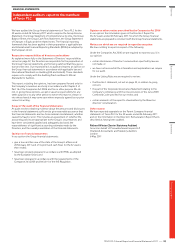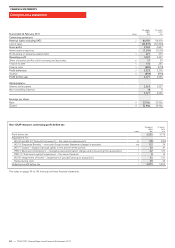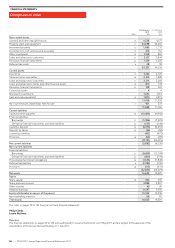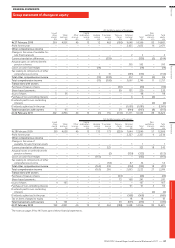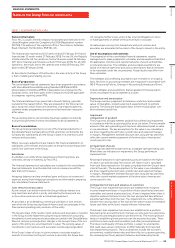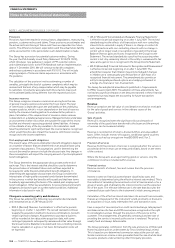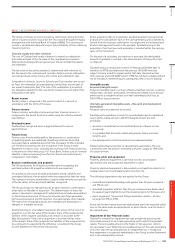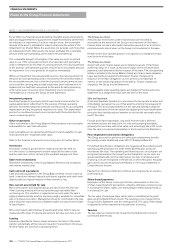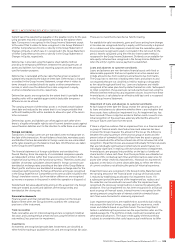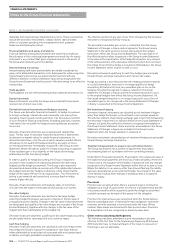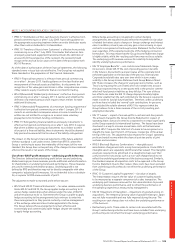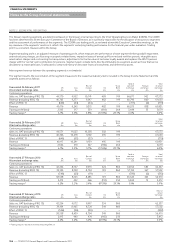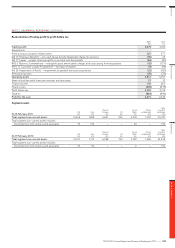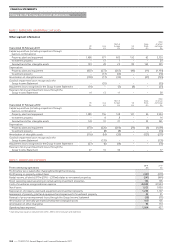Tesco 2011 Annual Report Download - page 103
Download and view the complete annual report
Please find page 103 of the 2011 Tesco annual report below. You can navigate through the pages in the report by either clicking on the pages listed below, or by using the keyword search tool below to find specific information within the annual report.
General information
Tesco PLC is a public limited company incorporated and domiciled in the
United Kingdom under the Companies Act 2006 (Registration number
445790). The address of the registered office is Tesco House, Delamare
Road, Cheshunt, Hertfordshire, EN8 9SL, UK.
The financial year represents the 52 weeks ended 26 February 2011 (prior
financial year 52 weeks ended 27 February 2010). For the UK, the Republic
of Ireland and the US, the results are for the 52 weeks ended 26 February
2011 (prior financial year 52 weeks ended 27 February 2010). For all other
operations, the results are for the calender year ended 28 February 2011
(year ended 28 February 2010).
As described in the Report of the Directors, the main activity of the Group
is that of retailing and retailing services.
Basis of preparation
The consolidated financial statements have been prepared in accordance
with International Financial Reporting Standards (IFRS) and IFRS
Interpretations Committee (IFRIC) interpretations as endorsed by the
European Union, and those parts of the Companies Act 2006 applicable
to companies reporting under IFRS.
The financial statements are presented in Pounds Sterling, generally
rounded to the nearest million. They are prepared on the historical cost
basis, except for certain financial instruments, share-based payments,
customer loyalty programmes and pensions that have been measured
at fair value.
The accounting policies set out below have been applied consistently
to all periods presented in these consolidated financial statements.
Basis of consolidation
The Group financial statements consist of the financial statements of
the ultimate Parent Company (Tesco PLC), all entities controlled by the
Company (its subsidiaries) and the Group’s share of its interests in joint
ventures and associates.
Where necessary, adjustments are made to the financial statements of
subsidiaries, joint ventures and associates to bring the accounting policies
used in line with those of the Group.
Subsidiaries
A subsidiary is an entity whose operating and financing policies are
controlled, directly or indirectly, by Tesco PLC.
The financial statements of subsidiaries are included in the consolidated
financial statements from the date that control commences until the
date that control ceases.
Intragroup balances and any unrealised gains and losses or income and
expenses arising from intragroup transactions are eliminated in preparing
the consolidated financial statements.
Joint ventures and associates
A joint venture is an entity in which the Group holds an interest on a
long-term basis and which is jointly controlled by the Group and one
or more other venturers under a contractual agreement.
An associate is an undertaking, not being a subsidiary or joint venture,
over which the Group has significant influence and can participate in the
financial and operating policy decisions of the entity.
The Group’s share of the results of joint ventures and associates is included
in the Group Income Statement using the equity method of accounting.
Investments in joint ventures and associates are carried in the Group Balance
Sheet at cost plus post-acquisition changes in the Group’s share of the net
assets of the entity, less any impairment in value. The carrying values of
investments in joint ventures and associates include acquired goodwill.
If the Group’s share of losses in a joint venture or associate equals or
exceeds its investment in the joint venture or associate, the Group does
not recognise further losses, unless it has incurred obligations to do so
or made payments on behalf of the joint venture or associate.
Unrealised gains arising from transactions with joint ventures and
associates are eliminated to the extent of the Group’s interest in the entity.
Use of assumptions and estimates
The preparation of the consolidated financial statements requires
management to make judgements, estimates and assumptions that affect
the application of policies and reported amounts of assets and liabilities,
income and expenses. The estimates and associated assumptions are
based on historical experience and various other factors that are believed
to be reasonable under the circumstances. Actual results may differ from
these estimates.
The estimates and underlying assumptions are reviewed on an ongoing
basis. Revisions to accounting estimates are recognised in accordance with
IAS 8 ‘Accounting Policies, Changes in Accounting Estimates and Errors’.
Critical estimates and assumptions that are applied in the preperation
of the consolidated financial statements include:
Depreciation and amortisation
The Group exercises judgement to determine useful lives and residual
values of intangibles, property, plant and equipment and investment
property. The assets are depreciated down to their residual values over
their estimated useful lives.
Impairment
i) Impairment of goodwill
The Group tests annually whether goodwill has suffered any impairment
in accordance with the accounting policy as set out below. The recoverable
amount of the cash-generating units has been determined based on value
in use calculations. The key assumptions for the value in use calculations
are those regarding discount rates, growth rates and expected changes
in margins. Management estimate discount rates using pre-tax rates that
reflect the current market assessment of the time value of money and
country specific risks.
ii) Impairment of assets
The Group has determined each store as a separate cash-generating unit.
Where there are indicators for impairment, the Group performs an
impairment test.
Recoverable amounts for cash-generating units are based on the higher
of value in use and fair value less costs to sell. Value in use is calculated
from cash flow projections for five years using data from the Group’s latest
internal forecasts. The key assumptions for the value in use calculations
are those regarding discount rates, growth rates and expected changes
in margins. Management estimate discount rates using pre-tax rates that
reflect the current market assessment of the time value of money and
country specific risks.
iii) Impairment of loans and advances to customers
The Group’s loan impairment provisions are established to recognise
incurred impairment losses in its portfolio of loans classified as loans and
receivables and carried at amortised cost. A loan is impaired when there is
objective evidence that events since the loan was granted have affected
expected cash flows from the loan. The impairment loss is the difference
between the carrying value of the loan and the present value of estimated
future cash flows at the loan’s original effective interest rate.
The Group’s loan impairment provisions are established on a portfolio
basis taking into account the level of arrears, security, past loss experience,
credit scores and defaults based on portfolio trends. The most significant
factors in establishing these provisions are the expected loss rates. These
portfolios include credit card receivables and other personal advances.
The future credit quality of these portfolios is subject to uncertainties
that could cause actual credit losses to differ materially from reported
loan impairment provisions. These uncertainties include the economic
environment, notably interest rates and their effect on customer spending,
the unemployment level, payment behaviour and bankruptcy trends.
NOTE 1 ACCOUNTING POLICIES
FINANCIAL STATEMENTS
TESCO PLC Annual Report and Financial Statements 2011
—
99
Overview Business review Governance Financial statements
Notes to the Group financial statements


